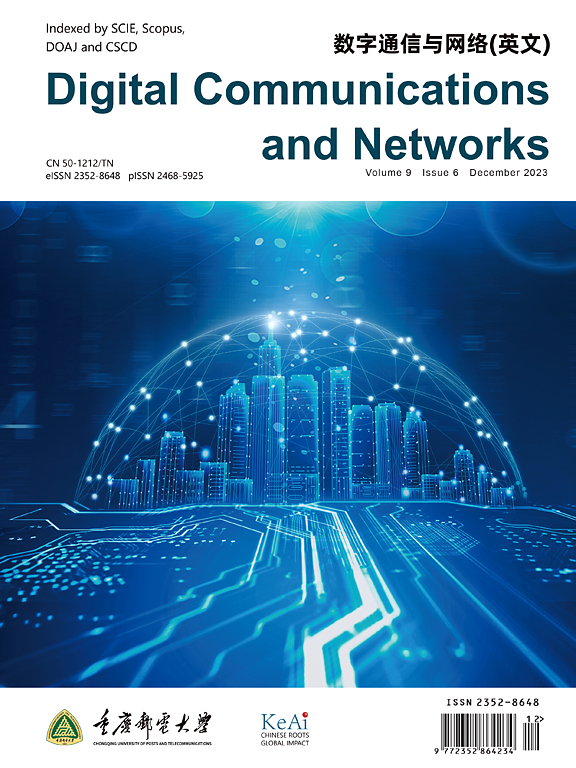通过符号级预编码增强广义接收空间调制:有或没有智能反射面的设计指南
IF 7.5
2区 计算机科学
Q1 TELECOMMUNICATIONS
引用次数: 0
摘要
现有的带有符号级预编码(SLP)的广义接收空间调制(GRSM)将非预期天线处的接收信号(不含噪声)强制为零,这限制了对预期接收天线产生强建设性干扰,从而限制了采用零强制(ZF)预编码的GRSM性能的提高。在本文中,我们提出了一种新的GRSM-SLP方案,该方案放松了零接收功率约束,并通过集成智能反射面(IRSs)来获得优越的性能。具体来说,我们先进的GRSM-RSLP联合利用发射器处的SLP和IRS处的无源波束形成来最大限度地提高预期和非预期接收天线之间的功率差,其中非预期天线处的接收信号被放松到以原点为中心的球体中,该球体的半径取决于信噪比(SNR)值。通过相移键控和正交调幅信号交替优化预编码矩阵和无源波束形成矢量。值得强调的是,GRSM-RSLP是一个通用的解决方案,也适用于没有IRS的系统,尽管它在IRS辅助系统中表现更好。最后,我们进行了大量的仿真,以证明GRSM-RSLP优于GRSM-ZF和GRSM-SLP。仿真结果表明,GRSM-RSLP的性能受非预期天线数量的影响较大,且非预期天线数量越大,其性能越好。在最佳情况下,与GRSM-SLP和GRSM-ZF相比,GRSM-RSLP的信噪比增益分别可达10.5 dB和12.5 dB。本文章由计算机程序翻译,如有差异,请以英文原文为准。
Enhancing generalized receive spatial modulation by symbol-level precoding: Design guidelines with or without intelligent reflecting surfaces
Existing Generalized Receive Spatial Modulation (GRSM) with Symbol-Level Precoding (SLP) forces the received signals (excluding noise) at unintended antennas to be zero, which restricts the generation of strong constructive interference to intended receive antennas and thus limits the performance improvement over conventional GRSM with Zero-Forcing (ZF) precoding. In this paper, we propose a novel GRSM-SLP scheme that relaxes the zero receive power constraint and achieves superior performance by integrating Intelligent Reflecting Surfaces (IRSs). Specifically, our advanced GRSM-RSLP jointly exploits SLP at the transmitter and passive beamforming at the IRS to maximize the power difference between intended and unintended receive antennas, where the received signals at unintended antennas are relaxed to lie in a sphere centered at origin with a preset radius that depends on the Signal-to-Noise Ratio (SNR) value. The precoding matrix and passive beamforming vectors are optimized alternately by considering both phase shift keying and quadrature amplitude modulation signaling. It is worth emphasizing that GRSM-RSLP is a universal solution, also applicable to systems without IRS, although it performs better in IRS-assisted systems. We finally conduct extensive simulations to prove the superiority of GRSM-RSLP over GRSM-ZF and GRSM-SLP. Simulation results show that the performance of GRSM-RSLP is significantly influenced by the number of unintended antennas, and the larger the number, the better its performance. In the best-case scenario, GRSM-RSLP can achieve SNR gains of up to 10.5 dB and 12.5 dB over GRSM-SLP and GRSM-ZF, respectively.
求助全文
通过发布文献求助,成功后即可免费获取论文全文。
去求助
来源期刊

Digital Communications and Networks
Computer Science-Hardware and Architecture
CiteScore
12.80
自引率
5.10%
发文量
915
审稿时长
30 weeks
期刊介绍:
Digital Communications and Networks is a prestigious journal that emphasizes on communication systems and networks. We publish only top-notch original articles and authoritative reviews, which undergo rigorous peer-review. We are proud to announce that all our articles are fully Open Access and can be accessed on ScienceDirect. Our journal is recognized and indexed by eminent databases such as the Science Citation Index Expanded (SCIE) and Scopus.
In addition to regular articles, we may also consider exceptional conference papers that have been significantly expanded. Furthermore, we periodically release special issues that focus on specific aspects of the field.
In conclusion, Digital Communications and Networks is a leading journal that guarantees exceptional quality and accessibility for researchers and scholars in the field of communication systems and networks.
 求助内容:
求助内容: 应助结果提醒方式:
应助结果提醒方式:


